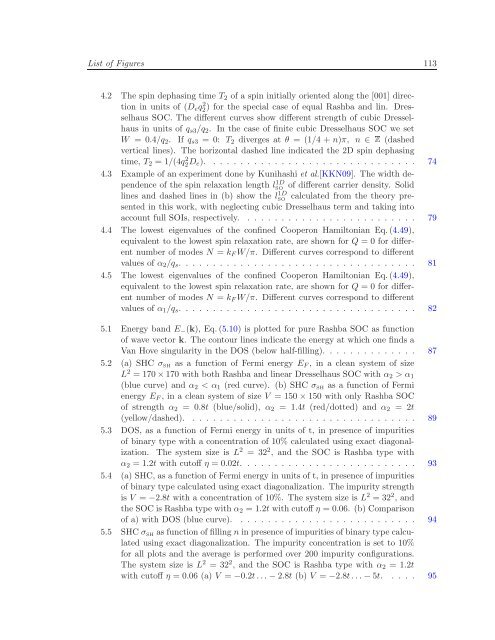Itinerant Spin Dynamics in Structures of ... - Jacobs University
Itinerant Spin Dynamics in Structures of ... - Jacobs University
Itinerant Spin Dynamics in Structures of ... - Jacobs University
You also want an ePaper? Increase the reach of your titles
YUMPU automatically turns print PDFs into web optimized ePapers that Google loves.
List <strong>of</strong> Figures 113<br />
4.2 The sp<strong>in</strong> dephas<strong>in</strong>g time T 2 <strong>of</strong> a sp<strong>in</strong> <strong>in</strong>itially oriented along the [001] direction<br />
<strong>in</strong> units <strong>of</strong> (D e q2 2 ) for the special case <strong>of</strong> equal Rashba and l<strong>in</strong>. Dresselhaus<br />
SOC. The different curves show different strength <strong>of</strong> cubic Dresselhaus<br />
<strong>in</strong> units <strong>of</strong> q s3 /q 2 . In the case <strong>of</strong> f<strong>in</strong>ite cubic Dresselhaus SOC we set<br />
W = 0.4/q 2 . If q s3 = 0: T 2 diverges at θ = (1/4 + n)π, n ∈(dashed<br />
vertical l<strong>in</strong>es). The horizontal dashed l<strong>in</strong>e <strong>in</strong>dicated the 2D sp<strong>in</strong> dephas<strong>in</strong>g<br />
time, T 2 = 1/(4q2 2D e). . . . . . . . . . . . . . . . . . . . . . . . . . . . . . . 74<br />
4.3 Example <strong>of</strong> an experiment done by Kunihashi et al.[KKN09]. The width dependence<br />
<strong>of</strong> the sp<strong>in</strong> relaxation length l 1D<br />
SO<br />
<strong>of</strong> different carrier density. Solid<br />
l<strong>in</strong>es and dashed l<strong>in</strong>es <strong>in</strong> (b) show the l 1D<br />
SO<br />
calculated from the theory presented<br />
<strong>in</strong> this work, with neglect<strong>in</strong>g cubic Dresselhaus term and tak<strong>in</strong>g <strong>in</strong>to<br />
account full SOIs, respectively. . . . . . . . . . . . . . . . . . . . . . . . . . 79<br />
4.4 The lowest eigenvalues <strong>of</strong> the conf<strong>in</strong>ed Cooperon Hamiltonian Eq.(4.49),<br />
equivalent to the lowest sp<strong>in</strong> relaxation rate, are shown for Q = 0 for different<br />
number <strong>of</strong> modes N = k F W/π. Different curves correspond to different<br />
values <strong>of</strong> α 2 /q s . . . . . . . . . . . . . . . . . . . . . . . . . . . . . . . . . . . 81<br />
4.5 The lowest eigenvalues <strong>of</strong> the conf<strong>in</strong>ed Cooperon Hamiltonian Eq.(4.49),<br />
equivalent to the lowest sp<strong>in</strong> relaxation rate, are shown for Q = 0 for different<br />
number <strong>of</strong> modes N = k F W/π. Different curves correspond to different<br />
values <strong>of</strong> α 1 /q s . . . . . . . . . . . . . . . . . . . . . . . . . . . . . . . . . . . 82<br />
5.1 Energy band E − (k), Eq.(5.10) is plotted for pure Rashba SOC as function<br />
<strong>of</strong> wave vector k. The contour l<strong>in</strong>es <strong>in</strong>dicate the energy at which one f<strong>in</strong>ds a<br />
Van Hove s<strong>in</strong>gularity <strong>in</strong> the DOS (below half-fill<strong>in</strong>g). . . . . . . . . . . . . . 87<br />
5.2 (a) SHC σ SH as a function <strong>of</strong> Fermi energy E F , <strong>in</strong> a clean system <strong>of</strong> size<br />
L 2 = 170×170 with both Rashba and l<strong>in</strong>ear Dresselhaus SOC with α 2 > α 1<br />
(blue curve) and α 2 < α 1 (red curve). (b) SHC σ SH as a function <strong>of</strong> Fermi<br />
energy E F , <strong>in</strong> a clean system <strong>of</strong> size V = 150×150 with only Rashba SOC<br />
<strong>of</strong> strength α 2 = 0.8t (blue/solid), α 2 = 1.4t (red/dotted) and α 2 = 2t<br />
(yellow/dashed). . . . . . . . . . . . . . . . . . . . . . . . . . . . . . . . . . 89<br />
5.3 DOS, as a function <strong>of</strong> Fermi energy <strong>in</strong> units <strong>of</strong> t, <strong>in</strong> presence <strong>of</strong> impurities<br />
<strong>of</strong> b<strong>in</strong>ary type with a concentration <strong>of</strong> 10% calculated us<strong>in</strong>g exact diagonalization.<br />
The system size is L 2 = 32 2 , and the SOC is Rashba type with<br />
α 2 = 1.2t with cut<strong>of</strong>f η = 0.02t. . . . . . . . . . . . . . . . . . . . . . . . . . 93<br />
5.4 (a) SHC, as a function <strong>of</strong> Fermi energy <strong>in</strong> units <strong>of</strong> t, <strong>in</strong> presence <strong>of</strong> impurities<br />
<strong>of</strong> b<strong>in</strong>ary type calculated us<strong>in</strong>g exact diagonalization. The impurity strength<br />
is V = −2.8t with a concentration <strong>of</strong> 10%. The system size is L 2 = 32 2 , and<br />
the SOC is Rashba type with α 2 = 1.2t with cut<strong>of</strong>f η = 0.06. (b) Comparison<br />
<strong>of</strong> a) with DOS (blue curve). . . . . . . . . . . . . . . . . . . . . . . . . . . 94<br />
5.5 SHC σ SH as function <strong>of</strong> fill<strong>in</strong>g n <strong>in</strong> presence <strong>of</strong> impurities <strong>of</strong> b<strong>in</strong>ary type calculated<br />
us<strong>in</strong>g exact diagonalization. The impurity concentration is set to 10%<br />
for all plots and the average is performed over 200 impurity configurations.<br />
The system size is L 2 = 32 2 , and the SOC is Rashba type with α 2 = 1.2t<br />
with cut<strong>of</strong>f η = 0.06 (a) V = −0.2t...−2.8t (b) V = −2.8t...−5t. . . . . 95
















